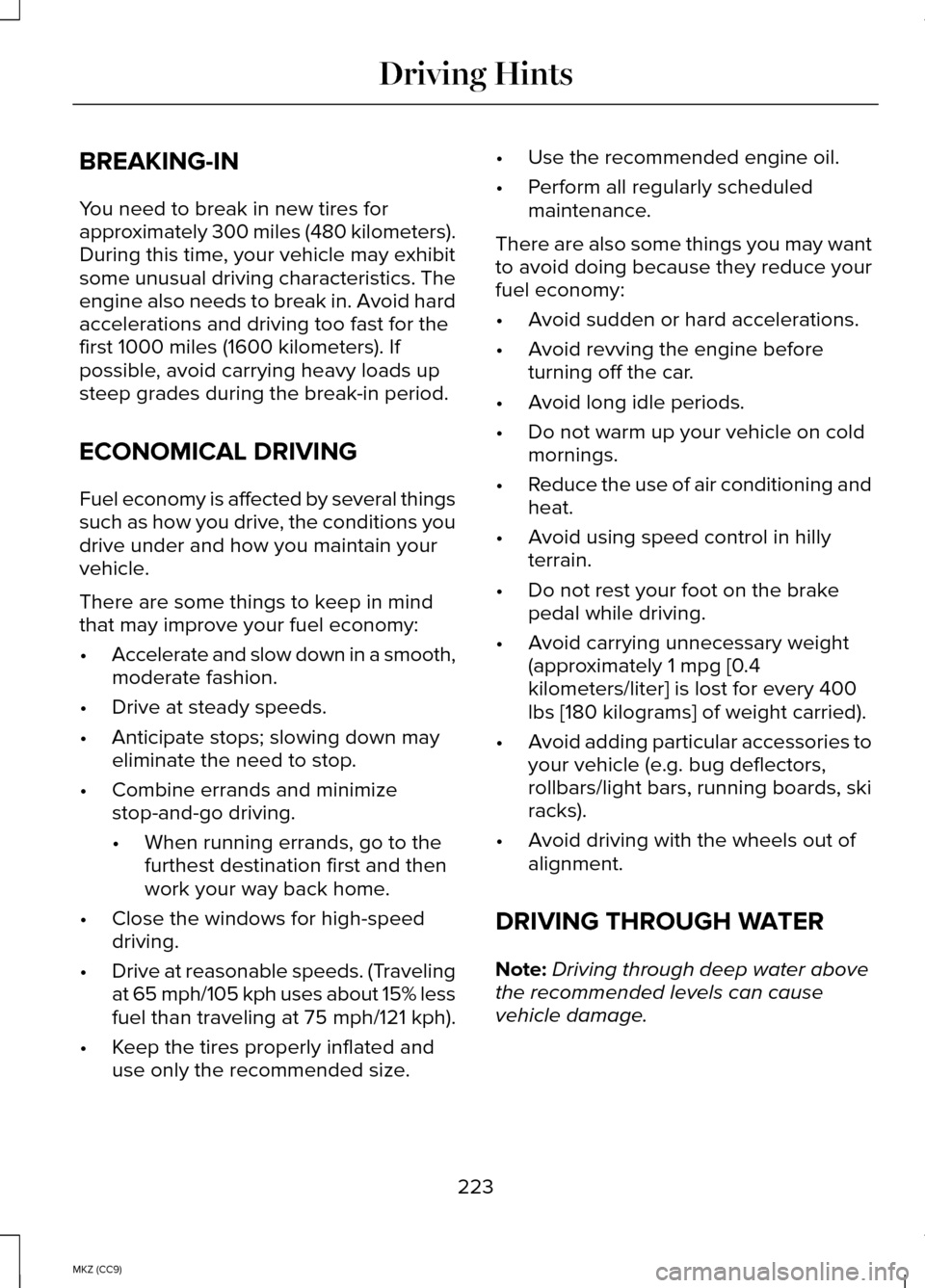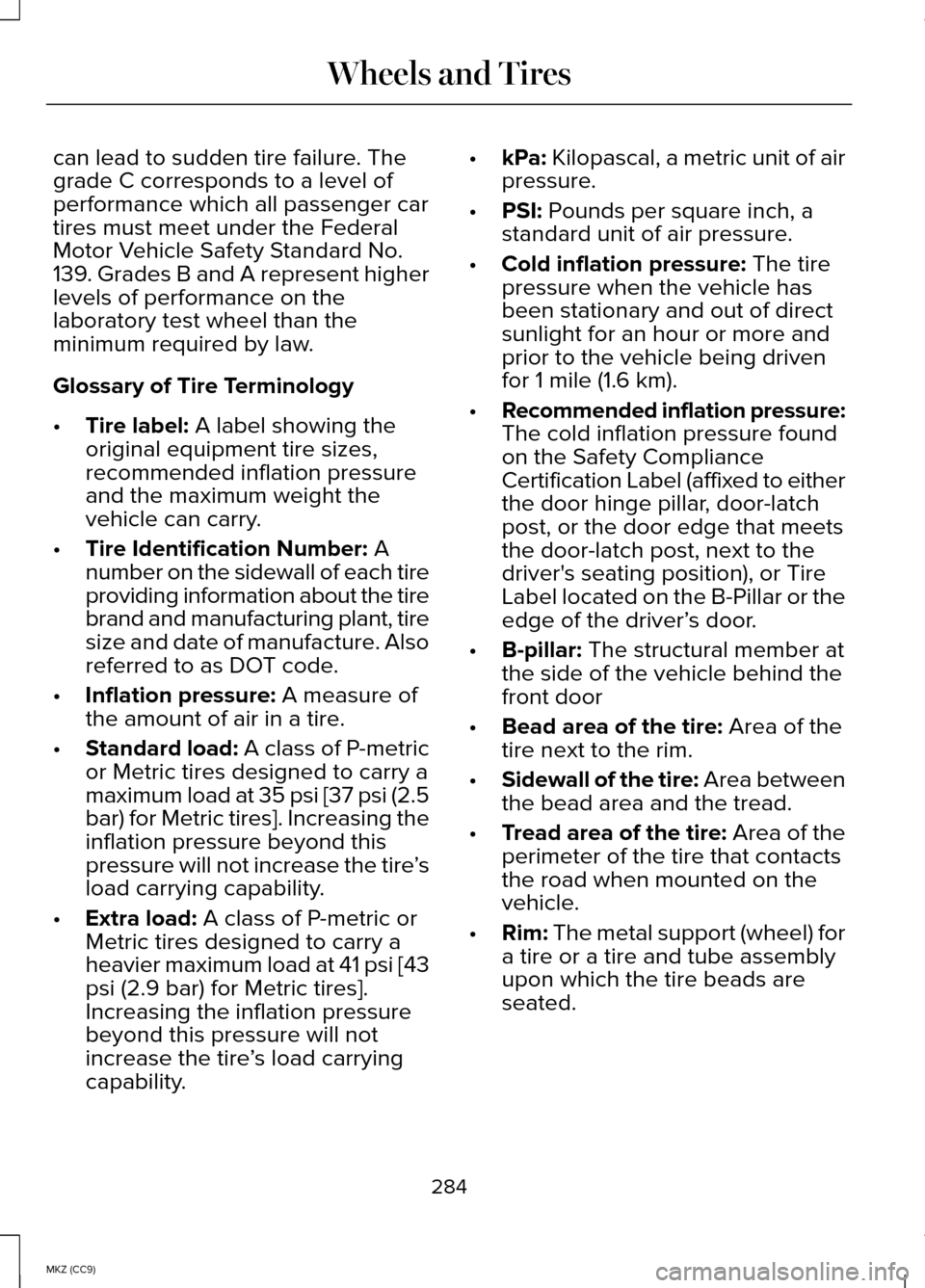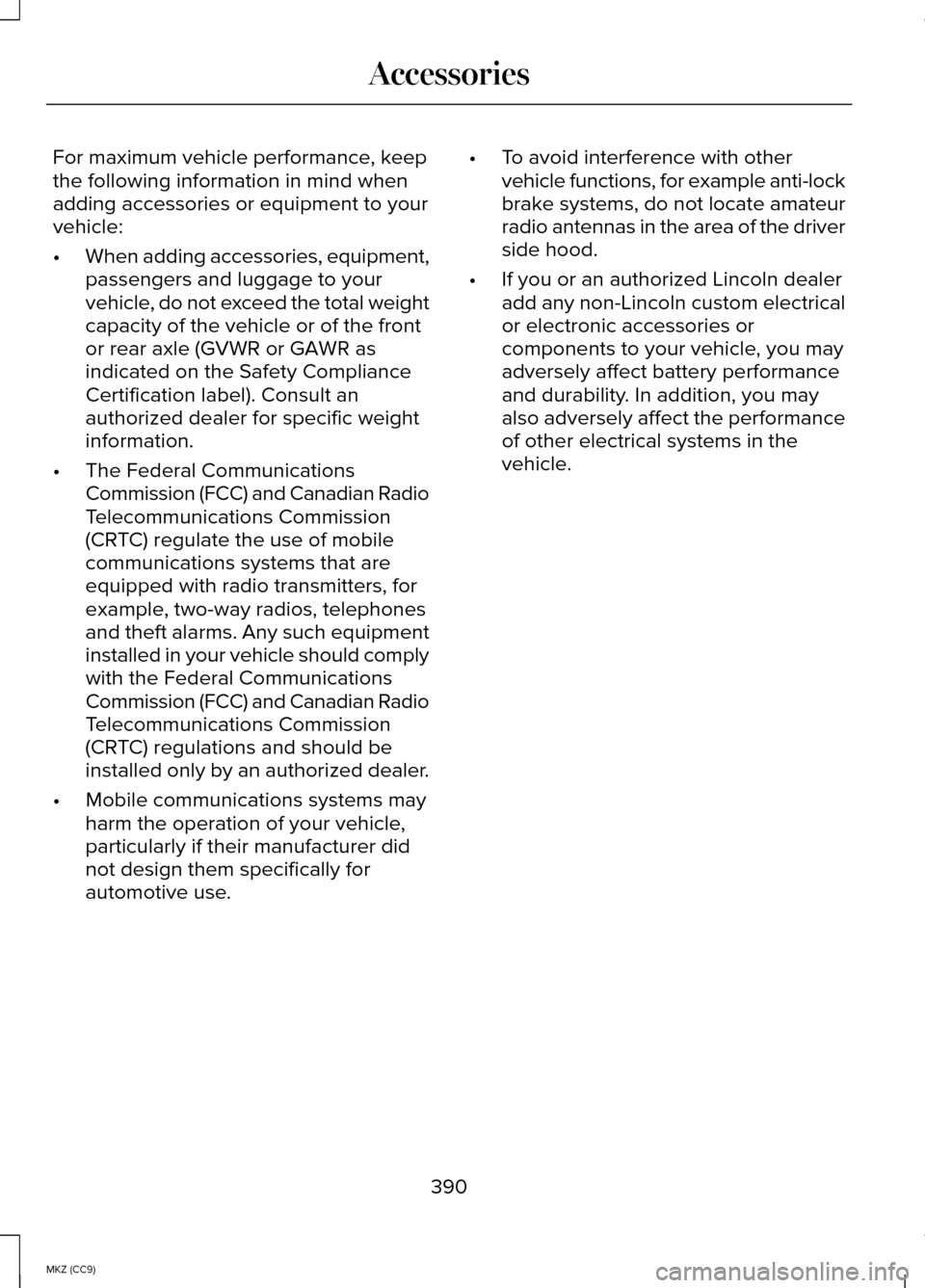2014 LINCOLN MKZ HYBRID weight
[x] Cancel search: weightPage 222 of 445

be: 1400 - (5 x 220) - (5 x 30) = 1400 -
1100 - 150 = 150 pounds. Yes, you
have enough load capacity in your
vehicle to transport four friends and
your golf bags. In metric units, the
calculation would be: 635 kilograms -
(5 x 99 kilograms) - (5 x 13.5 kilograms)
= 635 - 495 - 67.5 = 72.5 kilograms.
*Suppose your vehicle has a
1400-pound (635-kilogram) cargo and
luggage capacity. You and one of your
friends decide to pick up cement from
the local home improvement store to
finish that patio you have been
planning for the past two years.
Measuring the inside of the vehicle
with the rear seat folded down, you
have room for twelve 100-pound
(45-kilogram) bags of cement. Do you
have enough load capacity to
transport the cement to your home?
If you and your friend each weigh 220
pounds (99 kilograms), the calculation
would be: 1400 - (2 x 220) - (12 x 100)
= 1400 - 440 - 1200 = - 240 pounds.
No, you do not have enough cargo
capacity to carry that much weight. In
metric units, the calculation would be:
635 kilograms - (2 x 99 kilograms) -
(12 x 45 kilograms) = 635 - 198 - 540
= -103 kilograms. You will need to
reduce the load weight by at least 240
pounds (104 kilograms). If you remove
three 100-pound (45-kilogram) cement
bags, then the load calculation would
be: 1400 - (2 x 220) - (9 x 100) = 1400
- 440 - 900 = 60 pounds. Now you
have the load capacity to transport the
cement and your friend home. In
metric units, the calculation would be:
635 kilograms - (2 x 99 kilograms) - (9
x 45 kilograms) = 635 - 198 - 405 = 32
kilograms.
The above calculations also assume
that the loads are positioned in your
vehicle in a manner that does not
overload the Front or the Rear Gross
Axle Weight Rating specified for your
vehicle on the Safety Compliance
Certification Label. The label shall be
affixed to either the door hinge pillar,
door-latch post, or the door edge that
meets the door-latch post, next to the
driver's seating position.
220
MKZ (CC9) Load Carrying
Page 225 of 445

BREAKING-IN
You need to break in new tires for
approximately 300 miles (480 kilometers).
During this time, your vehicle may exhibit
some unusual driving characteristics. The
engine also needs to break in. Avoid hard
accelerations and driving too fast for the
first 1000 miles (1600 kilometers). If
possible, avoid carrying heavy loads up
steep grades during the break-in period.
ECONOMICAL DRIVING
Fuel economy is affected by several things
such as how you drive, the conditions you
drive under and how you maintain your
vehicle.
There are some things to keep in mind
that may improve your fuel economy:
•
Accelerate and slow down in a smooth,
moderate fashion.
• Drive at steady speeds.
• Anticipate stops; slowing down may
eliminate the need to stop.
• Combine errands and minimize
stop-and-go driving.
•When running errands, go to the
furthest destination first and then
work your way back home.
• Close the windows for high-speed
driving.
• Drive at reasonable speeds. (Traveling
at 65 mph/105 kph uses about 15% less
fuel than traveling at 75 mph/121 kph).
• Keep the tires properly inflated and
use only the recommended size. •
Use the recommended engine oil.
• Perform all regularly scheduled
maintenance.
There are also some things you may want
to avoid doing because they reduce your
fuel economy:
• Avoid sudden or hard accelerations.
• Avoid revving the engine before
turning off the car.
• Avoid long idle periods.
• Do not warm up your vehicle on cold
mornings.
• Reduce the use of air conditioning and
heat.
• Avoid using speed control in hilly
terrain.
• Do not rest your foot on the brake
pedal while driving.
• Avoid carrying unnecessary weight
(approximately 1 mpg [0.4
kilometers/liter] is lost for every 400
lbs [180 kilograms] of weight carried).
• Avoid adding particular accessories to
your vehicle (e.g. bug deflectors,
rollbars/light bars, running boards, ski
racks).
• Avoid driving with the wheels out of
alignment.
DRIVING THROUGH WATER
Note: Driving through deep water above
the recommended levels can cause
vehicle damage.
223
MKZ (CC9) Driving Hints
Page 286 of 445

can lead to sudden tire failure. The
grade C corresponds to a level of
performance which all passenger car
tires must meet under the Federal
Motor Vehicle Safety Standard No.
139. Grades B and A represent higher
levels of performance on the
laboratory test wheel than the
minimum required by law.
Glossary of Tire Terminology
•
Tire label: A label showing the
original equipment tire sizes,
recommended inflation pressure
and the maximum weight the
vehicle can carry.
• Tire Identification Number:
A
number on the sidewall of each tire
providing information about the tire
brand and manufacturing plant, tire
size and date of manufacture. Also
referred to as DOT code.
• Inflation pressure:
A measure of
the amount of air in a tire.
• Standard load:
A class of P-metric
or Metric tires designed to carry a
maximum load at 35 psi [37 psi (2.5
bar) for Metric tires]. Increasing the
inflation pressure beyond this
pressure will not increase the tire ’s
load carrying capability.
• Extra load:
A class of P-metric or
Metric tires designed to carry a
heavier maximum load at 41 psi [43
psi (2.9 bar) for Metric tires].
Increasing the inflation pressure
beyond this pressure will not
increase the tire ’s load carrying
capability. •
kPa:
Kilopascal, a metric unit of air
pressure.
• PSI:
Pounds per square inch, a
standard unit of air pressure.
• Cold inflation pressure:
The tire
pressure when the vehicle has
been stationary and out of direct
sunlight for an hour or more and
prior to the vehicle being driven
for 1 mile (1.6 km).
• Recommended inflation pressure:
The cold inflation pressure found
on the Safety Compliance
Certification Label (affixed to either
the door hinge pillar, door-latch
post, or the door edge that meets
the door-latch post, next to the
driver's seating position), or Tire
Label located on the B-Pillar or the
edge of the driver’ s door.
• B-pillar:
The structural member at
the side of the vehicle behind the
front door
• Bead area of the tire:
Area of the
tire next to the rim.
• Sidewall of the tire: Area between
the bead area and the tread.
• Tread area of the tire: Area of the
perimeter of the tire that contacts
the road when mounted on the
vehicle.
• Rim:
The metal support (wheel) for
a tire or a tire and tube assembly
upon which the tire beads are
seated.
284
MKZ (CC9) Wheels and Tires
Page 287 of 445

Information Contained on the Tire
Sidewall
Both U.S. and Canada Federal
regulations require tire manufacturers
to place standardized information on
the sidewall of all tires. This
information identifies and describes
the fundamental characteristics of the
tire and also provides a U.S. DOT Tire
Identification Number for safety
standard certification and in case of a
recall.
Information on P Type Tires
P215/65R15 95H is an example of a
tire size, load index and speed rating.
The definitions of these items are
listed below. (Note that the tire size,
load index and speed rating for your
vehicle may be different from this
example.) A. P: Indicates a tire, designated by
the Tire and Rim Association, that may
be used for service on cars, sport
utility vehicles, minivans and light
trucks. Note: If your tire size does not
begin with a letter this may mean it is
designated by either the European
Tire and Rim Technical Organization
or the Japan Tire Manufacturing
Association.
B.
215: Indicates the nominal width of
the tire in millimeters from sidewall
edge to sidewall edge. In general, the
larger the number, the wider the tire.
C. 65: Indicates the aspect ratio which
gives the tire's ratio of height to width.
D.
R: Indicates a radial type tire.
E.
15: Indicates the wheel or rim
diameter in inches. If you change your
wheel size, you will have to purchase
new tires to match the new wheel
diameter.
F.
95: Indicates the tire's load index.
It is an index that relates to how much
weight a tire can carry. You may find
this information in your owner’ s
manual. If not, contact a local tire
dealer.
Note: You may not find this
information on all tires because it is
not required by federal law.
G.
H: Indicates the tire's speed rating.
The speed rating denotes the speed
at which a tire is designed to be driven
for extended periods of time under a
standard condition of load and
inflation pressure. The tires on your
vehicle may operate at different
285
MKZ (CC9) Wheels and TiresH
I
J
KL
M
A
B
CDEFG
E142543
Page 306 of 445

VEHICLE IDENTIFICATION
NUMBER
The vehicle identification number is
located on the left-hand side of the
instrument panel.
Please note that in the graphic, XXXX is
representative of your vehicle
identification number.
The Vehicle Identification Number contains
the following information: World manufacturer identifier
A
Brake system, Gross Vehicle
Weight Rating, Restraint Devices
and their locations
B
Make, vehicle line, series, body
type
C
Engine type
D
Check digit
E
Model year
F
Assembly plant
G
Production sequence number
H
304
MKZ (CC9) Capacities and SpecificationsE142476 E142477
Page 392 of 445

For maximum vehicle performance, keep
the following information in mind when
adding accessories or equipment to your
vehicle:
•
When adding accessories, equipment,
passengers and luggage to your
vehicle, do not exceed the total weight
capacity of the vehicle or of the front
or rear axle (GVWR or GAWR as
indicated on the Safety Compliance
Certification label). Consult an
authorized dealer for specific weight
information.
• The Federal Communications
Commission (FCC) and Canadian Radio
Telecommunications Commission
(CRTC) regulate the use of mobile
communications systems that are
equipped with radio transmitters, for
example, two-way radios, telephones
and theft alarms. Any such equipment
installed in your vehicle should comply
with the Federal Communications
Commission (FCC) and Canadian Radio
Telecommunications Commission
(CRTC) regulations and should be
installed only by an authorized dealer.
• Mobile communications systems may
harm the operation of your vehicle,
particularly if their manufacturer did
not design them specifically for
automotive use. •
To avoid interference with other
vehicle functions, for example anti-lock
brake systems, do not locate amateur
radio antennas in the area of the driver
side hood.
• If you or an authorized Lincoln dealer
add any non-Lincoln custom electrical
or electronic accessories or
components to your vehicle, you may
adversely affect battery performance
and durability. In addition, you may
also adversely affect the performance
of other electrical systems in the
vehicle.
390
MKZ (CC9) Accessories